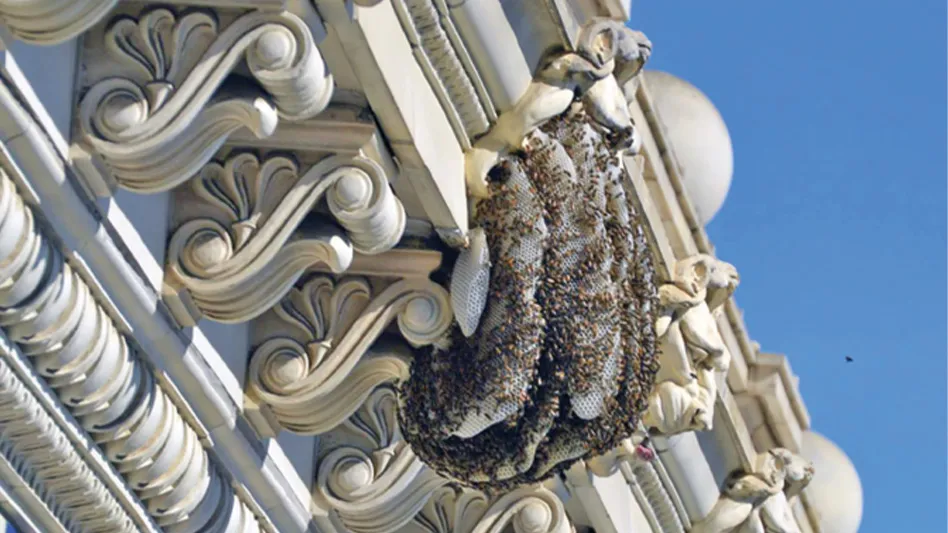August 1981. "Chlordane Kills Termites for Decades." I quoted work by R. Beal and V. Smith who found in 1971 that chlordane was repellant for at least 10 years. In the Journal of Economic Entomology in 1990, N. Su disputed this and reported that chlordane was not repellent. Su told me that test protocols may have been different. It is now a moot discussion but illustrates how highly regarded researchers can have different results.
October 1981. "Fabric Pests Are Killed by Cedar Wood Odors." New cedar wood chests can kill pests for only a few months. Before synthetics came on strong, PCOs profited greatly from the control of carpet beetles and clothes moths. Two things killed that business: synthetics and permanent mothproofing by sheep growers. Arnold Mallis discovered that when sheep were dipped in a weak solution of dieldrin to kill sheep bot flies, the toxicant was bound permanently to the wool. I predicted a resurgence of fabric pest populations when these toxicants were lost. I was wrong. This "resurgence" is very slow in developing.
December 1981. "DDT is a Cancer-Causing Pesticide!" In this article I described how DDT was not a carcinogen and how it was cancelled for political reasons. Unfortunately, DDT was the first pest control domino to fall and the beginning of the loss of most of the valuable tools that our industry needed to protect health and the environment. Hundreds of published papers by eminent biologists agreed.
July 1982. "Humidity is No Bar to Desiccants." This article is relevant today. (During the years when liquids replaced dusts as the primary control agent, Mallis was criticized for including a chapter on dusts in one of the early editions of the Handbook of Pest Control.) The article on dusts showed that high humidity does not reduce the effectiveness of dust. Even Drione was 100% effective after it dried.
August 1982. "Of Rug Pads and Insecticides." I feared that spraying rugs for control would injure the foam pad under the rug. I was wrong. The composition of pads and sprays has vastly improved since 1982. There is no problem now because virtually no one sprays a rug for fleas or carpet beetles.
September 1982. "Kill ’em Deader." Excesses in application of toxicants were more common 20 years ago. Fortunately our industry has gone a long way in reducing the volume of toxicants used in homes. But some ads still brag "we kill ’em dead."
October 1982. "Fabric pests cannot damage synthetics." They definitely can and do. But this is a moot problem now. There is still occasional damage to synthetic fabrics by fabric pests and some occasional pests.
February 1983. "Controlling Drywood Termites and Wood Destroying Beetles with a Unique Needle Treatment Procedure." This method is still preferred instead of fumigation if no more than three or four infested sites are found.
March 1983. Untitled article. Temperature and humidity still have an important effect on delivery and performance of many pest control products. When dust is warmed, it has greater reach than damp, cool dust.
June 1983. Untitled article. Carpenter bees can not penetrate painted wood. They are able to penetrate wood coated with latex paints but not wood coated with oil-based paints. I wrote then that latex coating was no barrier. Perhaps newer latex paint formulations are different than they were years ago.
July 1983. Untitled article. Drainage systems break with age from tree roots, settling soil, etc. Periplaneta cockroaches can dive into traps and emerge indoors. Rodents frequently do enter homes via the commode. Drain flies thrive in this environments. Years ago, I recommended Elcocene, a mix of orthodichlorobenze and coal tar disinfectant. Today, I would recommend the technique developed by Bob Stoddard while he was in charge of pest control at the Grand Rapids Public Schools in Michigan. Bob uses Super C, an enzyme cleaner. If you want data call him at 800/226-0418.
Space limits many themes that appeared during these l8 years. I’ll review some of the more relevant ones in future stories.
Katz may be reached at 954/427-9716.

Explore the December 1999 Issue
Check out more from this issue and find your next story to read.
Latest from Pest Control Technology
- NPMA Presents Industry Awards at PestWorld 2024
- PCT, Syngenta Honor Crown Leadership Winners at PestWorld Ceremony
- Drain Flies and Fruit Flies in Food Facilities
- A Leg Up
- Chicago Named No. 1 on Orkin's Rattiest Cities List for 10 Consecutive Years
- NPMA Reflects on Sustained Growth, New Initiatives at Pest World ’24
- Envu Signs Definitive Agreement to Acquire In2Care
- Second October Hurricane Disrupts Business Operations, Pest Pressure for Southern PCOs





